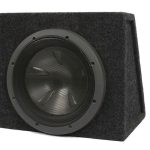Subwoofers play a huge role in a car audio system. They add punchy bass, something that regular speakers can’t. This is because subwoofers are specially designed to reproduce low frequencies in a sound signal. Low-frequency sound is what is commonly known as bass. While a subwoofer is a must-have sound equipment for a bass enthusiast, most people get confused about terms such as wattage, impedance, and resistance. In this article, we compare 2-ohm vs 4-ohm subwoofer.
Resistance, to be specific, is a term hardly known by most people. You’ve probably seen the term ohms or this Ω sign on a subwoofer. To help you understand better, it’ll help to know what resistance means. Basically, resistance is a measure of the opposition to the flow of electric current by an electric circuit. Resistance is denoted in ohms.
Subwoofers are usually fed with an audio signal in the form of an electric current from a head unit or amplifier. They have a certain level of resistance to an audio signal. Most subwoofers available today have a resistance rating of either 2 ohms or 4 ohms. Although your stereo or amp may work just okay with either a 2 or 4 ohm sub, it would help to know which would work best for the best bass quality. Thus, let’s look at what each resistance rating in a subwoofer means.
2 Ohm Subwoofer
When buying a subwoofer and notice a subwoofer rated as 2 ohm, it means that its resistance is level as at 2 ohms. A 2 ohm rating is on the lower side, meaning that it doesn’t have a lot of resistance in its circuit. As such, an amplifier is able to feed it with more power without much resistance. Since the resistance is low, it means that the sub will be louder. However, it consumes more power due to its minimal resistance, and this leads to lower quality in bass.
4 Ohm Subwoofer
A subwoofer with a resistance rating of 4 ohms means that it has higher resistance. As such, it reproduces less sound due to its high resistance. Consequently, it doesn’t deliver loud bass. However, its high resistance means that it consumes less power from an amplifier. It also reproduces more compact sound such that you’ll get higher quality bass despite it being less loud.
What if you have multiple Subwoofers?
If you want to use multiple subwoofers in your car, the kind of wiring option you’ll choose will determine their resistance. You can wire subwoofers either in series or parallel. Series wiring means that you’ll wire the subs one after the other, and this means the negative terminal of one sub will be connected to the positive terminal of the next sub. In parallel wiring, you’ll simply wire the terminals of one sub to similar terminals of the other sub such that the positive terminals are wired together and the negative terminals are also wired together.
If you wire the subwoofers in series, you’ll end up getting higher resistance. For instance, if you wire two subwoofers in series, each with a resistance of 2-ohms, the total resistance will be their resistances added together, which is to mean 2+2, thus a total resistance of 4 ohms. On the other hand, if you wire subwoofers in parallel, the total resistance is the resistance of one subwoofer divided by the total number of subwoofers. For instance, if you wire two subwoofers in parallel, each with a resistance of 2 ohms, then the total resistance will be 2/2, thus a total resistance of 1 ohm. This means that wiring subwoofers in parallel lowers the total resistance.
What if a subwoofer has dual voice coils?
While most subwoofers have a single voice coil, others come with dual voice coils. You can have a sub with a dual voice coil where each voice coil has a resistance of 2 ohms or 4 ohms. In this case, the kind of wiring you’ll use to connect it to an amplifier will determine the overall resistance of the dual voice coil subwoofer. For instance, if you have a subwoofer with a dual voice coil where each coil has a resistance of 4 ohms, you can choose to wire it in series to have more overall resistance of 4+4 (8 ohms) or wire it in parallel to have a lower resistance of 4/2 (1 ohm).
Which is better between a 2-ohm vs 4-ohm subwoofer?
Now that you know the key differences between 2 ohm and 4 ohm subs, including how wiring multiple subwoofers affect the total resistance, it can be easier to tell which option is better. Basically, either option is good. However, the kind of bass you want will determine the option you’ll choose between the two. If you want bass at a moderate volume and in the best quality, then a 4 ohm subwoofer will be your best bet. Also, you’ll need to connect multiple subwoofers in series for higher resistance, thus higher quality bass. On the other hand, if you want the loudest bass, then consider a 2-ohm amplifier and if you have multiple subs, then connect them in series for less resistance and thus more loudness.
Frequently Asked Questions
Q: Which ohm is best for subs?
A: Generally, 2-ohm subwoofers offer louder bass output than 4-ohm subwoofers. Thus, 2-ohm subs are ideal for higher volumes, but 4-ohm subs offer better sound quality.
Q: Do ohms affect sound quality?
A: Yes. Higher ohms offer better sound quality. Thus, a 4-ohm subwoofer sounds better than a 2-ohm subwoofer.
Q: How many watts is 2 ohms?
A: The maximum power output for a 2 ohm subwoofer is 550 watts.
Q: How many watts is 4 ohms?
A: The maximum power output for a 4 ohm subwoofer is 350 watts.
Also Read: 4 Ohm Vs 8 Ohm Speaker- Which Is Better?
Conclusion
Getting the kind of bass you want in your car is not a matter of hooking up just any subwoofer you come across in the market. There is a lot more that matters. The kind of resistance that the sub has will determine the loudness and quality of bass you’ll get. It’ll also determine the amount of power the sub will demand from the car amplifier or head unit. Basically, a 2 ohm subwoofer demands less power from the amp and tends to deliver louder bass. On the contrary, a 4 ohm subwoofer will demand more power from the amp and deliver less loud but higher quality bass. Thus, make your choice depending on the kind of bass you want when choosing between 2-ohm vs 4-ohm subwoofer.
Michael Evanchuk is a San Francisco-based sound engineer with 20 years’ experience installing, troubleshooting, and repairing commercial, automotive, and household sound equipment. Evanchuk owns an auto stereo center, where he offers highly competitive car audio installation and repair services. He has written dozens of articles on different sound engineering topics, all of which have been published in leading journals, blogs, and websites.





